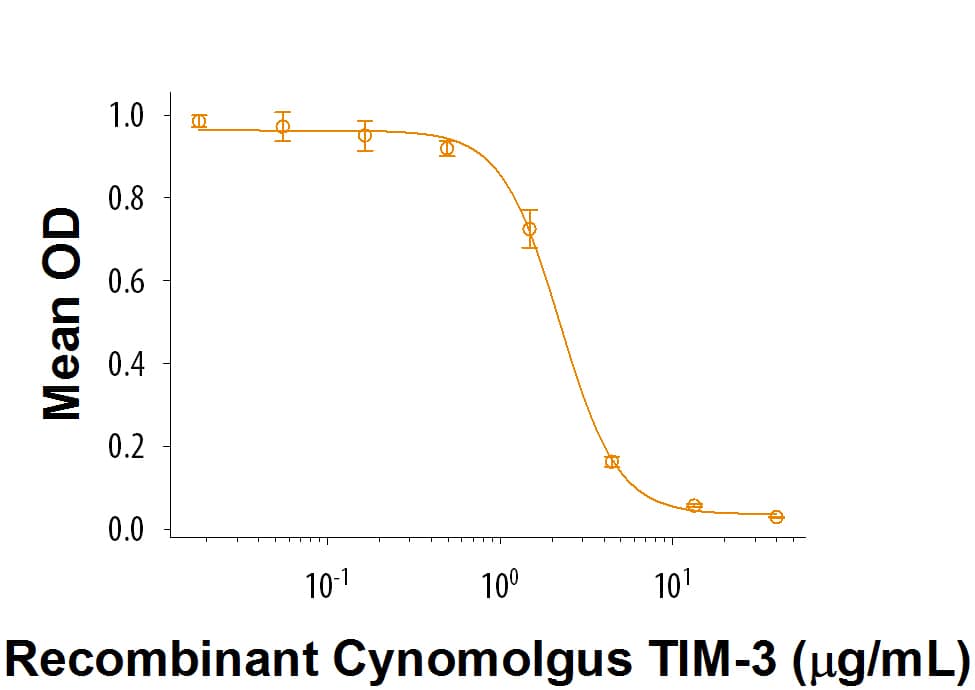Recombinant Cynomolgus Monkey TIM-3 Fc Chimera Protein, CF
R&D Systems, part of Bio-Techne | Catalog # 7914-TM

Key Product Details
- R&D Systems HEK293-derived Recombinant Cynomolgus Monkey TIM-3 Fc Chimera Protein (7914-TM)
- Quality control testing to verify active proteins with lot specific assays by in-house scientists
- All R&D Systems proteins are covered with a 100% guarantee
Source
Accession #
Structure / Form
Conjugate
Applications
Product Specifications
Source
| Cynomolgus Monkey TIM-3 (Ser22-Arg201) Accession # EHH54703 |
IEGRMD | Human IgG1 (Pro100-Lys330) |
| N-terminus | C-terminus |
Purity
Endotoxin Level
N-terminal Sequence Analysis
Predicted Molecular Mass
SDS-PAGE
Activity
The ED50 for this effect is 0.5-3 μg/mL.
Measured by its binding ability in a functional ELISA.
When Recombinant Human Galectin‑9 (Catalog # 2045-GA) is immobilized at 0.5 µg/mL (100 µL/well), the concentration of Recombinant Cynomolgus Monkey TIM‑3 Chimera that produces 50% of the optimal binding response is 0.2-1.2 μg/mL.
Reviewed Applications
Read 1 review rated 5 using 7914-TM in the following applications:
Scientific Data Images for Recombinant Cynomolgus Monkey TIM-3 Fc Chimera Protein, CF
Recombinant Cynomolgus Monkey TIM-3 Fc Chimera Protein Bioactivity
Recombinant Cynomolgus Monkey TIM-3 (Catalog # 7914-TM) inhibits anti-CD3 antibody induced IL-2 secretion in human T lymphocytes. The ED50 for this effect is 0.5-3 μg/mL.Formulation, Preparation and Storage
7914-TM
| Formulation | Lyophilized from a 0.2 μm filtered solution in PBS. |
| Reconstitution |
Reconstitute at 100 μg/mL in PBS.
|
| Shipping | The product is shipped at ambient temperature. Upon receipt, store it immediately at the temperature recommended below. |
| Stability & Storage | Use a manual defrost freezer and avoid repeated freeze-thaw cycles.
|
Background: TIM-3
TIM‑3 (T cell immunoglobulin and mucin domain‑3), also known as HAVCR2, is a 60 kDa member of the TIM family of immune regulating molecules. TIMs are type I transmembrane glycoproteins with one Ig‑like V‑type domain and a Ser/Thr‑rich mucin stalk region (1, 2). Mature cynomolgus TIM‑3 consists of a 182 amino acid (aa) extracellular domain (ECD), a 21 aa transmembrane segment, and a 78 aa cytoplasmic tail. Within the ECD, cynomolgus (or crab‑eating macaque) monkey TIM‑3 shares 81%, 57%, and 56% aa sequence identity with human, mouse, and rat TIM‑3, respectively. TIM‑3 is up‑regulated on several populations of activated myeloid cells (macrophage, monocyte, dendritic cell, microglia, mast cell) and T cells (Th1, CD8+, NK, Treg) (3‑10). Its binding to Galectin‑9 induces a range of immunosuppressive functions which enhance immune tolerance and inhibit anti‑tumor immunity (11). TIM‑3 ligation attenuates CD8+ and Th1 cell responses (11‑13) and promotes the activity of Treg and myeloid derived suppressor cells (8, 11, 13, 14). In addition, dendritic cell‑expressed TIM‑3 dampens inflammation by enabling the phagocytosis of apoptotic cells and the cross‑presentation of apoptotic cell antigens (3). It also binds the alarmin HMGB1, thereby preventing the activation of TLRs in response to released tumor cell DNA (6). Soluble TIM‑3 is also reported to inhibit the response of T cells to both Ag‑induced and concurrent CD3/CD28 stimulation (15). By contrast, TIM‑3 interactions with Galectin‑9 can trigger immune stimulatory effects, such as the coactivation of NK cell cytotoxicity (10).
References
- Sakuishi, K. et al. (2011) Trends Immunol. 32:345.
- Anderson, A.C. (2012) Curr. Opin. Immunol. 24:213.
- Nakayama, M. et al. (2009) Blood 113:3821.
- Anderson, A.C. et al. (2007) Science 318:1141.
- Wiener, Z. et al. (2007) J. Invest. Dermatol. 127:906.
- Chiba, S. et al. (2012) Nat. Immunol. 13:832.
- Monney, L. et al. (2002) Nature 415:536.
- Sanchez-Fueyo, A. et al. (2003) Nat. Immunol. 4:1093.
- Ndhlovu, L.C. et al. (2012) Blood 119:3734.
- Gleason, M.K. et al. (2012) Blood 119:3064.
- Zhu, C. et al. (2005) Nat. Immunol. 6:1245.
- Sakhdari, A. et al. (2012) PLoS ONE 7:e40146.
- Sabatos, C.A. et al. (2003) Nat. Immunol. 4:1102.
- Dardalhon, V. et al. (2010) J. Immunol. 185:1383.
- Geng, H. et al. (2006) J. Immunol. 176:1411.
Long Name
Alternate Names
Entrez Gene IDs
Gene Symbol
UniProt
Additional TIM-3 Products
Product Documents for Recombinant Cynomolgus Monkey TIM-3 Fc Chimera Protein, CF
Product Specific Notices for Recombinant Cynomolgus Monkey TIM-3 Fc Chimera Protein, CF
For research use only
